PICO WINE: THE HISTORY OF A HEROIC AND SUBVERSIVE WINE (PART II)
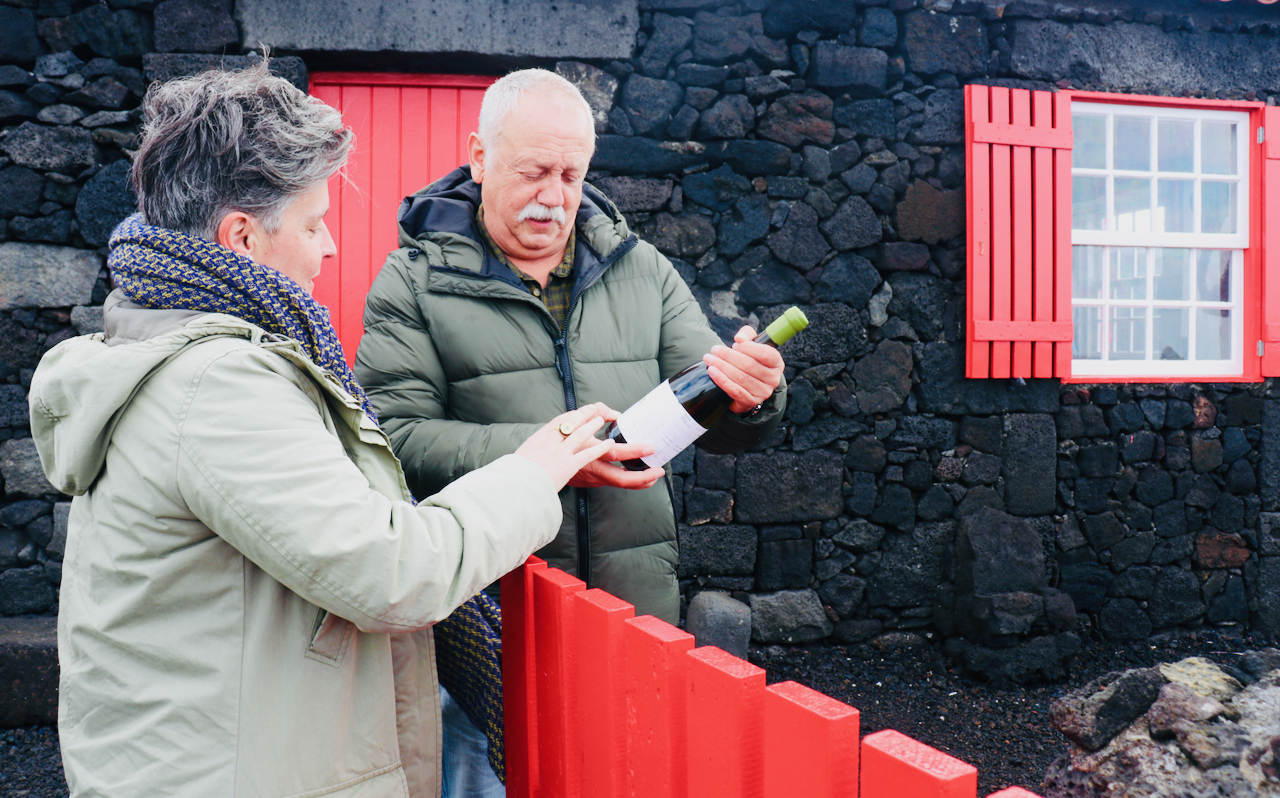
The early golden age of Pico wine
After being introduced in the Azores archipelago in the 15th century, the profusion of new vines extended to several islands, which due to natural reasons excluded the occidental group.
From subsistence strategy to exportation
The first reports of Azores wine exports date back to the 16th century, when the wine finally made it to international markets.
However, it was from the almost ungovernable Pico volcanic lava, after an epic landscape transformation was achieved, and thanks to the hard work of picarotos, that the wine production capacity was revealed, marked by the achievement of excellence!
At the end of the 17th century, Pico wine acquired the status of income source, conquering the world market (Meneses, 2010). The vineyards expanded on lava soils throughout the island, mainly around the region of Madalena.
This geographical expansion had several important indirect consequences to Pico island and its local inhabitants.
The multiplication of vines took place in non-arable soils, conquering the so-called biscoitos, that is areas formed by lava rock that present a slight decomposition but that are still very hard and intractable. As an effect, easier to plough lands became available for growing other crops, especially cereals and legumes.
This sudden blossoming wine production ended up dictating the creation of the municipality of Madalena (1723) on Pico island and the emergence of the port of Horta, in Faial.

Panoramic View of Madalena pier, from the ferry boat, during a day-trip to Faial.
The development of viticulture in the islands of the central group clearly changed the physiognomy of the Azores, particularly that of Pico and Faial.
Although production has always been limited, which contributes to a certain status of exclusivity with a price to match still today, Pico wine gained an international audience. During this period, these volcanic wines were a success particularly in the Americas, being one of the most consumed wines in New England and a staple in any wine cellar.
A wine worthy of the Czars
At the end of the 18th century, the Russian Czars had also developed a predilection for Pico wine and started importing the more concentrated and fortified version. It is said that when Czar Nicholas II of Russia was executed in 1917, bottles of Verdelho do Pico were found in his cellar!
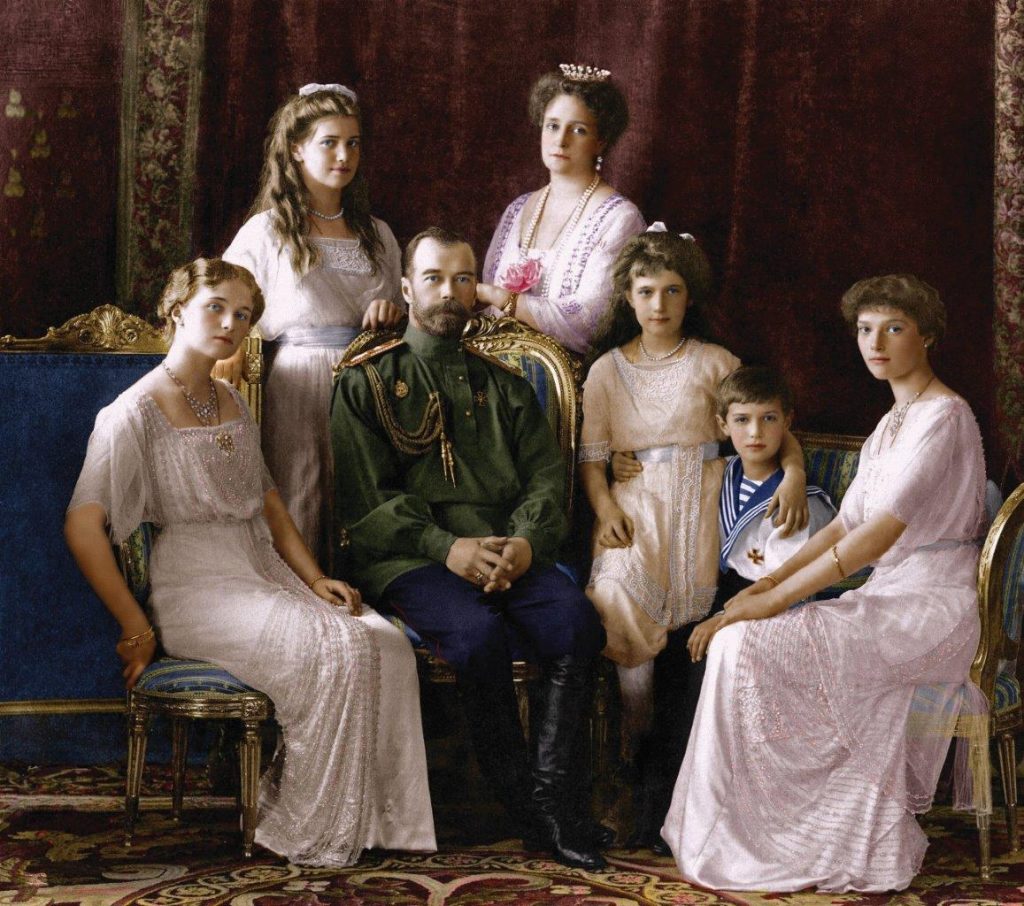
Nicholas II, Russia – Image: contunico © ZDF Enterprises GmbH, Mainz
During this period there was a substantial demographic increase in the Azores Central group. In fact, Pico became the third human agglomeration in the Azores, ahead of Faial and just behind Terceira and São Miguel!
In the heyday of Pico wine production it was necessary to limit the expansion of the vineyards, to control the unbridled desire to produce more each time! This is when the rule that vineyards could only be planted within 200 meters from the coast was established. Not only because this would preserve the character of the wine – that should grow “where we can hear the singing of the crab”, a sentence recently coined by António Maçanita – but also to free up arable soils and preserve the production of wood (which was at the time the only source of fuel in the island).
Pico and Faial: an unbalanced and subjugated relation
Faial played a big role in Pico’s wine industry. We could easily presume a cooperative and complementary marriage to exist between Pico island and Faial island. One had Pico had an exclusive volcanic soil and was producing a unique wine; on the other hand Faial had always been characterized by an excellent anchorage, essential to export goods when on an island.
But, what actually ended up happening was the development of an unbalanced power relation, mainly due to economic power, that will be transversal to the process by which Pico wine became internationally known and wanted.
This crystalized submissive relation would only later be transformed by catastrophic plant diseases.
The wealthy families from Faial
In Faial island vineyards were scarce. Therefore, in the 16th century, motivated by the geographical proximity and attracted to Pico’s wine potential, wealthy families from Faial gradually bought lands around Madalena, with the intention to plant vines. With it came a gradual emergence of manor houses along the coastline. The owners of the lands only casually visited Pico and they relied on picarotos for all the epic work that needed to be done in order to plant and maintain the vines.
The role these families played in the economic and administrative development of Madalena was crucial, for example by injecting money to build a municipal house and, as a consequence, many privileges were given to them, namely the free transport of their wines (from Pico to Faial).
Due to the characteristics of Pico land, soil was brought from Faial in small sailboats, to be poured into each opening where a vine cutting was planted.
At this time, the soil was purchased at fifty ‘reis’ for every forty liters. But this soil was in fact being extracted from the lands in Faial that belonged to the same wealthy families who bought lands in Pico. This closed circle reinforced the disadvantage for any picoroto who tried to own his own vineyards.
As time progressed, it became harder and harder for picarotos to economically compete with their neighbors.
Faial harbor: a displaced trajectory
It is known that Pico had the exclusive volcanic land and workforce, and that Faial had the economic power but also a safe port, which was essential to export from the islands.
Horta, the city facing Madela (Pico) had always been characterized by an excellent anchorage. Pico island, on the other hand, had a different coastline, which at the time was considered safe only for small boats.
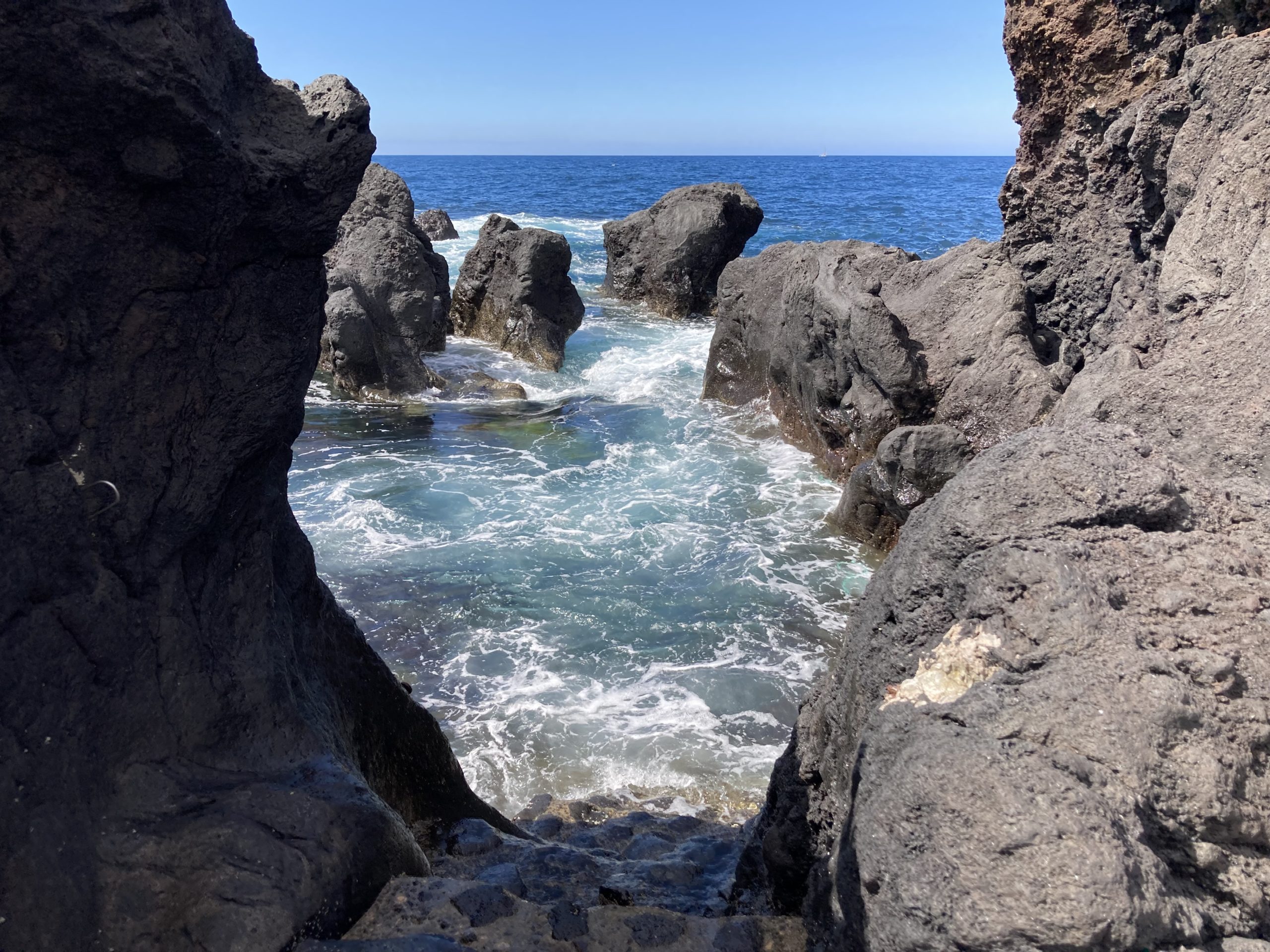
Rola-pipas in Pico island (pipe rollers)
These natural geographical conditions, to which we can add once again Faial’s investing power, dictated the creation of the new harbor in Horta, during the flourishing of Pico wine.
From then onwards, all the wine produced in Pico was transported to Faial. For this effect rola-pipas (lit. translation pipe rollers) were created. These are ramps carved into the lava rock from the inland and into the sea, which facilitated the sliding of the barrels towards the small boats that would transport the wine to Horta’s port, which was from here exported to the West Indies, United States, Brazil, Antilles, among other places. From this moment onwards, Pico wines started to be named after the port they were transported from – Fayal Wine (Macedo 1871). In Pico barrels were transported by ox carts, creating rilheiras, which are marks of the ground made by wheels erosion, still visible today (check the picture below, taken at the Lagido area).
In my opinion, this displaced trajectory results not only from a pragmatic fact but also from the interest of Faial in owning the reputation of this excellent wine. Of course, once again this was facilitated by an unbalanced economic power and Pico’s poor autonomy which had already translated into Pico’s belonging to Horta’s harbor captaincy from 1482 onwards.
The borderland (Fronteira)
During this period, Pico, the second biggest island in the Azores, “became dependent on Faial, particularly from the busy Horta” (1988). This relation, which had wine as its main interest, was mostly circumscribed to the western part of Pico, Madalena, an area which was back then named ‘borderland’ (Fronteira), as significant as the name can be.
In fact, as Meneses states (2010) the creation of the municipality of Madalena (in Pico) appears very late. In his opinion, the reasons for this delay lies in its proximity to Faial, which exerts considerable socio-political subjection over Pico. This was even more evident in the so-called borderland (Fronteira) and in Pico’s lack of economic dynamism that only emerged with the development of viticulture in the second half of the 17th century.
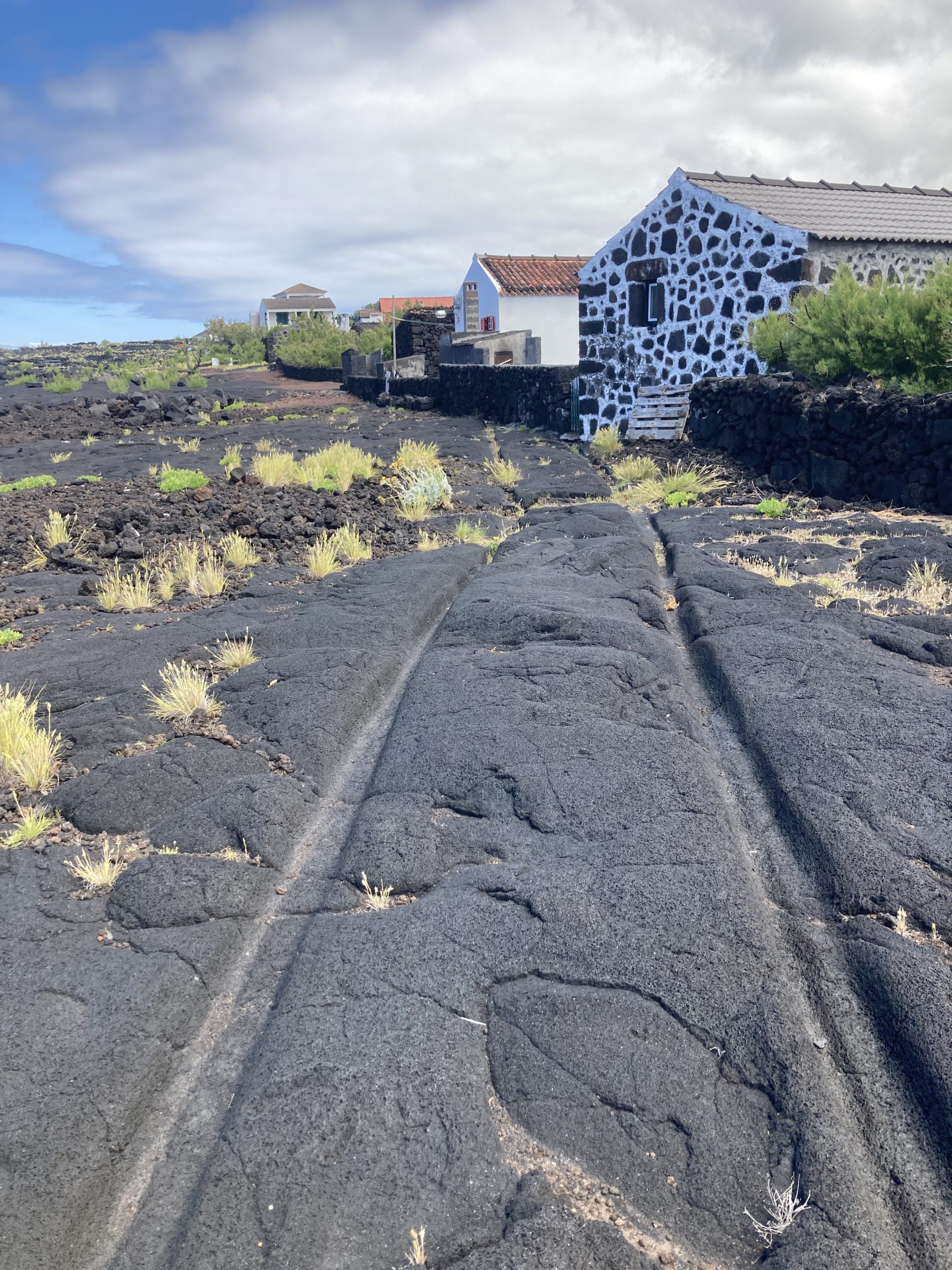
‘Rilheiras’ in Pico (marks on lava rock made by erosion, by the ox carts)
From our perspective, the acceptance of this borderland (Fronteira), evokes the absence of identity. Borders normally divide and connect, they exist in-between, but they belong nowhere.
These concepts and definitions, together with the events mentioned above, slowly but firmly installed a narrative and a relationship that had part of Pico island and its people subjugated, while their potentialities were clearly limited.
Exploring the history of an island like Pico through this perspective makes it difficult to connect the dots and imagine how, from this subjugated position, there was such a transformation that leads us to nowadays.
Presently, Pico island embodies a strong local identity and has become one of the most promising wine regions on the planet.
Ironically, this change happened thanks to a catastrophic event.
The decline of Pico Wine
The wine production on Pico Island reached its peak in the 19th century and unexpectedly declined due to catastrophic plant diseases.
Firstly the oidium (between 1852 and 1854) and then phylloxera plagues (from 1872 to 1874) completely destroyed the Azores vineyards – like it happened with most European vineyards at the time.
When this catastrophe took place, it was estimated that there were a total of 150 wine producers across Pico island.
These diseases had a huge economic and social effect on Pico, since wine production had become a subsistence strategy, a locally adapted project in an island where cereal culture was less favorable.
It wasn’t just vineyard owners who were impacted, but also everyone else who participated in the process of producing and transporting wine, such as barrel makers (coopers), sailors, basket makers, oxcart drivers and day laborers.
The lands, in which cracks were opened in the bedrock to receive the vines, became abandoned. Part of the population looked desperately for land to cultivate, which originated the maroiços, that is large mounds of loose lava stones resulting from parcels of land that were cleared to plant vegetable gardens to feed families.
Desertification, loss of soil, a ground that can not retain rainwater and the ‘cursed land’ seemed to be back.
During this period, half of the population from Pico and Faial islands migrated to the EUA.
During the 19th and 20th centuries, whale hunting also became a second alternative subsistence strategy.
Gradually, most autochthonous grapes became nearly extinct, with the exception of a few ones that were recently recovered and classified as centenarian vineyards, and that we have the opportunity to taste during our Culinary & Wine Trip to Pico.
Sulfur was effective against oidium, but the only solution for phylloxera was to switch from the autochthonous grapes – Verdelho dos Açores, Arinto e Terrantez – to disease-resistant vines imported from the United States. It wasn’t until the end of the last century that local growers began replanting Verdelho.
The so-called North American new grape, Isabella, was introduced by emigrants and proved to be more resistant to diseases. Isabella gave rise to vinho de cheiro, a new style of wine which became the most common across Pico island during the following decades.
Vinho de Cheiro
Around 1870, following these catastrophic plant diseases, grape variety Isabella, native to the United States, was brought to Pico by Manuel Faria da Terra Brum, son of Morgado Terra, the biggest grape grower in the Azores archipelago.
Resistant to diseases, and resulting in abundant harvests, Isabella’s red grapes became the most prevalent ones after the decimation of native vineyards by oidium and phylloxera.
Vinho de cheiro, which literally translates as “wine of scent”, can now be found on several of the islands across the Azores, such as São Miguel, Graciosa, Pico, Santa Maria and Terceira.
Concurrently with the spread of Isabella grapes, the production of Verdelho wine fell from thousands of barrels to only a few hundreds, and it became confined to small areas around Madalena and São Roque. 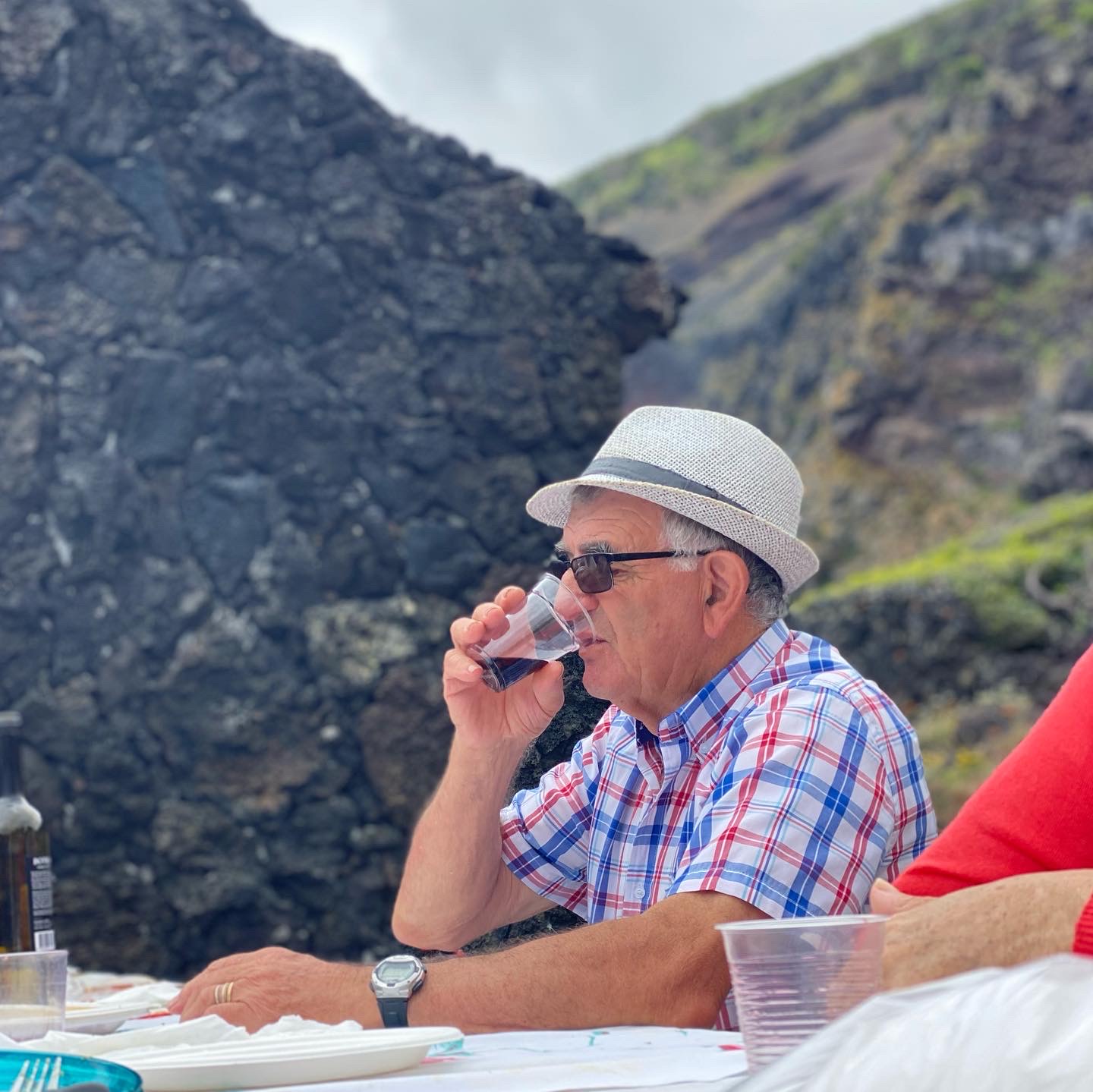
Initially, this red wine which was considered by winemakers of poor quality, did not inspire any commercial interest. Regardless of this appraisal, vinho de cheiro was responsible for a new wine democracy! At this time, every family started having at least a small plot in their backyard.
This wine, which is characterized by a low-alcohol content (typically 6-10%), is still today associated with local consumption among families and friends, but also used in cultural and religious ceremonies like the Holy Spirit celebrations and traditional local Azorean recipes.
In 1995 the European Union banned sales of vinho de cheiro within the Community, because of the alleged toxic effects of the grape, which until now have not been confirmed. Locals say that this ban was, in fact, due almost solely to reasons of commercial protection for wines from European grape varieties and not because of the actual quality of vinho de cheiro wine. Meanwhile, the Government of the Azores, and the Azorean deputies elected to the European Parliament, keep applying pressure on community entities to lift the sales ban.
As it is not currently commercialized, this means that you can only discover this delicacy when visiting the Azores islands! So come join us in Pico to sip homemade vinho de cheiro while you taste a traditional meal prepared by a local family.
This is just one of the wine discoveries you can do in Pico. The original Pico wines are also back in the meantime, and they are now better than ever. Sustainable, subversive and creative – combining tradition with innovation!
Pico Wine, a contemporary gaze
Traditional grapevines from Pico
During exhaustive prospecting work carried out (Mestre, 2016), it was possible to conclude that currently the oldest vines in the region are practically made up of three white grape varieties: Verdelho, Arinto dos Açores and Terrantez do Pico. These are par excellence, considered the native varieties of Pico.
 These varieties are unique in the national context, without their ancient presence being registered in Portugal’s mainland vineyards.
These varieties are unique in the national context, without their ancient presence being registered in Portugal’s mainland vineyards.
However, in previous records (São Romão, 1822) it is possible to identify other grape varieties on the islands of Pico and Faial, such as Alicante, Boal, Galego, Verdelho Valente and Terrantez do Monte, which are all white grapes, but also red varieties such as Bastardo and Tinta.
Historical references to the cultivation of vines in the Azores are generally scarce when it comes to the description of the varieties that were originally introduced to Pico island, as well as their origin.
Some authors indicate that the first varieties were brought from the island of Cyprus, while others came from the island of Madeira. It is known that the introduction to the cultivation of vines in Pico happened thanks to Frei Pedro Gigante who acquired the first vines.
Recovering the noble grape varieties
During the last 20 years, we have witnessed the expansion of the local wine industry and the recovery and reintroduction of the native grape varieties Verdelho, Terrantez do Pico and Arinto do Pico.
Several factors have contributed to this, and the creation of Pico Island Wine Cooperative, founded in 1949, was the first one. The cooperative recovered the noble grape varieties and the culture of the vineyard through the efforts of its member producers.
The classification of Pico vineyards as a Unesco World Heritage Area in 2004, along with the incoming European Community funds for the restructuring and conversion of Pico’s vineyards have very much contributed to the boost of Pico wine during the last decades.
As a consequence of this new World Heritage status, new investors – locals but also from the mainland and abroad – were attracted to the business of Pico wine production.
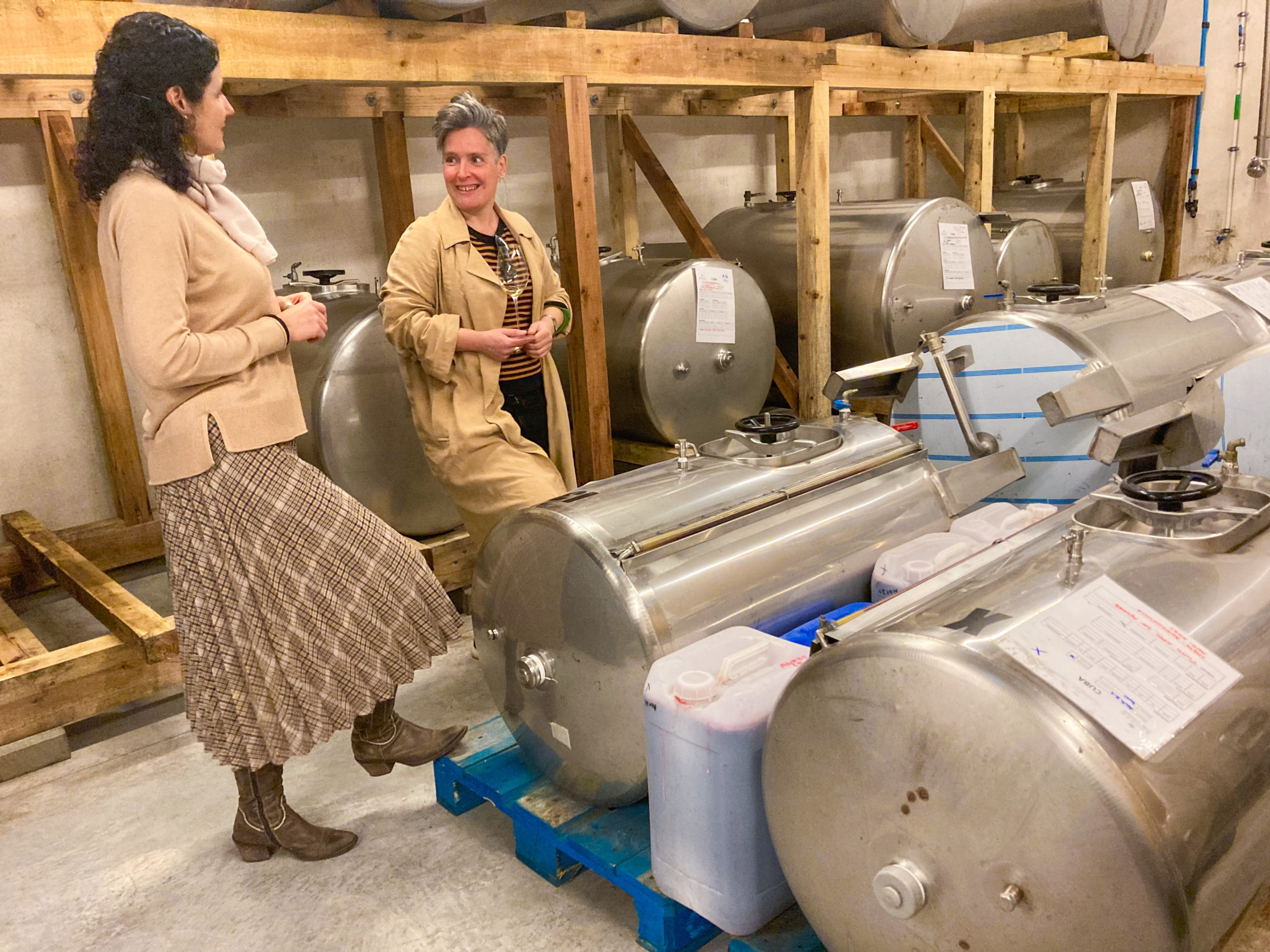
Silvia and Judite at Azores Wine Company winery
In 2004, only 240 hectares of vineyards were left in what is now considered the Pico Wine Landscape. Today it comes to more than 1200 hectares. And there are still lots of areas to grow: Losménio Goulard, the president of the Pico wine cooperative, recalls that around the 19th century, before phylloxera, there were 12000 hectares of vineyards planted in Pico.
But again, what in my opinion characterizes the contemporary and independent wine producers we meet in Pico is not quantity. Their concern is quality, authenticity, innovation… and low intervention with a strong sense of place!
Subversive and authentic Pico wine producers
Presently, the viniculture practices are carried out by individual owner-farmers without the use of mechanical vine-growing methods. There is a transversal hardness associated with Pico’s vineyards where all the work involves the strength of the hands. Some technology is added but without hiding the character of the island and the grapes. The plan is to let the best of the climate, soil and grape variety shine through.
Besides, not all the old vineyards were decimated. A few were left and today we can taste incrediblyunique wines from centenarian vines.
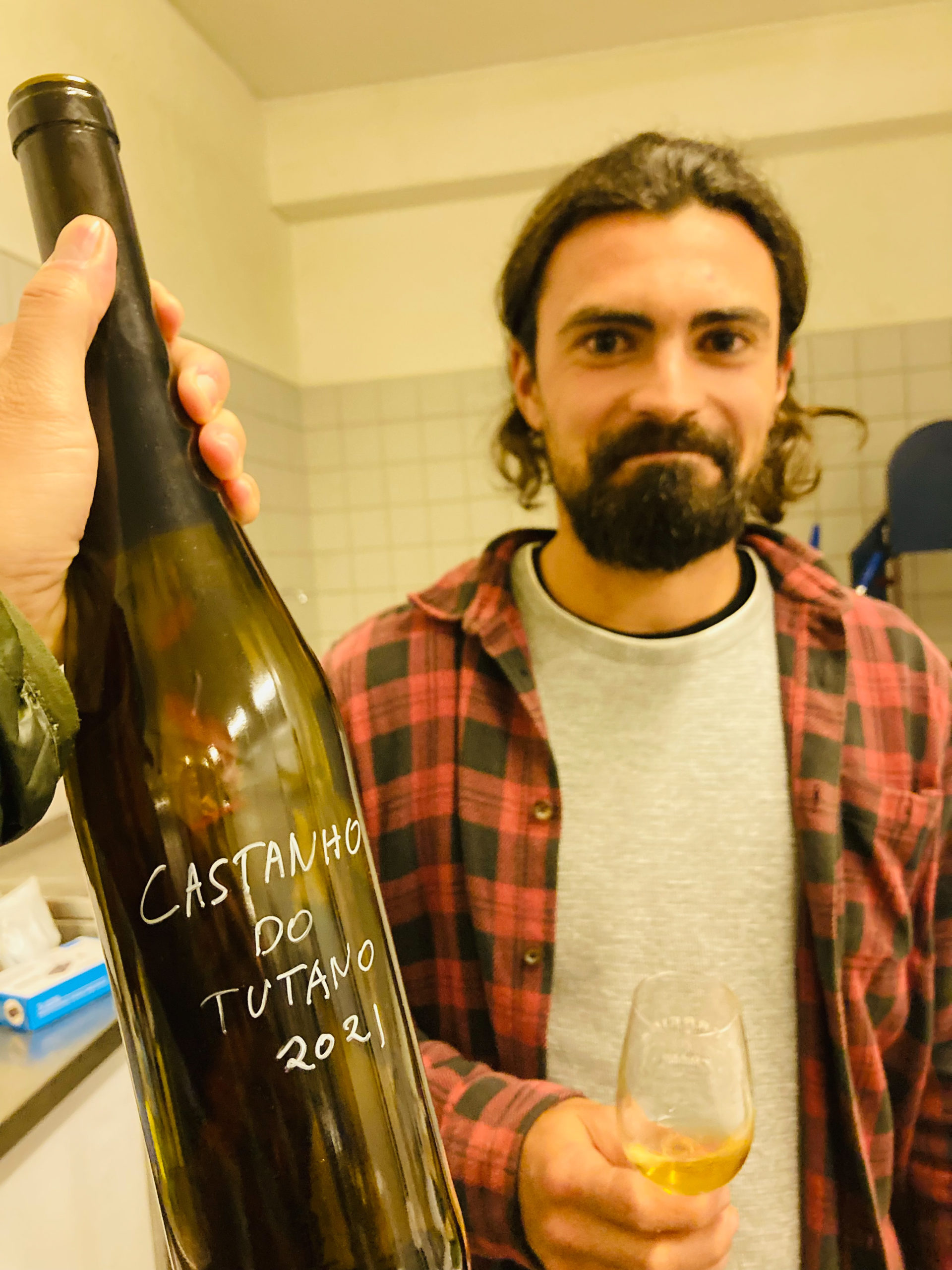
Entre Pedras enologist André Ribeiro
During our stays in Pico, we meet young producers, most of them picaroto men and women with impressive respect for the terroir and the landscape transformed by their ancestors five centuries ago. But also with strong creativity and capacity for risk taking, which have managed to surprise us with their consistency and determination.
For them, the “wine is done on the vine”, meaning that if you take care of the grape along the maturation process, by actually spending time at the vineyard, you will get an exceptional wine with no additives.
Cátia Laranjo is presently recovering a family wine situated in one of the most emblematic areas of Pico, while going against the ‘norm’ and producing red wines on an island where only white grapes are considered to be appropriate – and she has already won some prizes for it!
Entre Pedras, owned by two young male enologists, have some of their wines aging in bottles inside a natural cave, under the vineyards, an aging process as natural as the wine itself!
Azores Wine Company, a well-established producer, is responsible for producing wines that have conquered some of the most important wine accolades around the world, but their cellar which houses a wine hotel is also known for one of the most interesting architectural projects, regarding esthetics, sustainability, and local adaptability.
Czar is a producer who waits to harvest until the grapes are over-ripe, in order to produce a non-fortified wine that can reach 20% of alcohol. In years when Czar doesn’t end up losing his production, which can fairly easily happen because of excessive wind or rain, Czar wine can almost reach 1000 euros a bottle!
We could continue our list of favorite Pico wine producers, but we will save it for another moment. Or, you can just join us, in one of our Culinary Wine Trips to the Azores Islands, and meet them personally while tasting their wines in their original terroir.
A new era in Pico’s wine history: be a part of it!
Pico wine history is currently being re-written by its protagonists. Subversive, no longer subjugated, these picarotos now own the “cursed” land that welcomes them by producing rare pearls from a unique terroir. They are all rediscovering a tradition and richness that is intrinsic to the island and their own history and ancestors.
In parallel to this, what I see (and taste!) is the resistance of these wines, as if they were a living organism, surviving and becoming surprisingly authentic and avant-garde in their ways of growing and being.
The history of Pico island is being re-written and you can become one of the narrators!

Silvia at José’s winery and vineyards, at just 150 meters from the ocean.
Article by :
Sílvia Olivença (anthropologist and food guide/CEO at Oh! My Cod Ethnographic Food Tours & Trips)
Photos by:
Sílvia Olivença (anthropologist and food guide/CEO at Oh! My Cod Ethnographic Food Tours & Trips)
Zara Quiroga (food writer freelancer and food & cultural leader at Oh! My Cod Pico Trips)
Want to more about the Azores islands?
Pico Wine: one of the world’s most unique wine regions (Genesis – Part I)
Portuguese Easter sweet bread and Holy Spirit soups
Want to spend some time in the Azores, with us?
Check our culinary wine trip presentation below!
